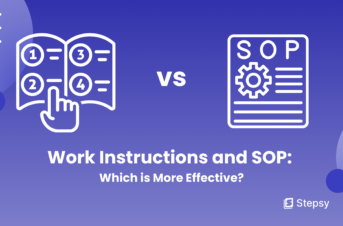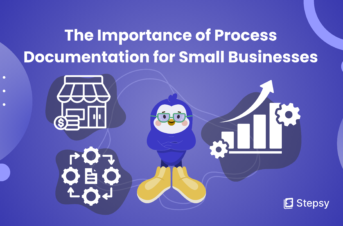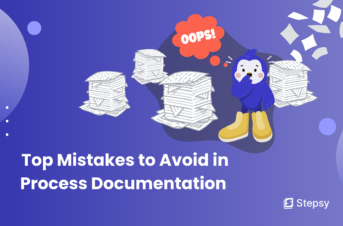Why Standard Operating Procedures (SOPs) are Important for Marketing
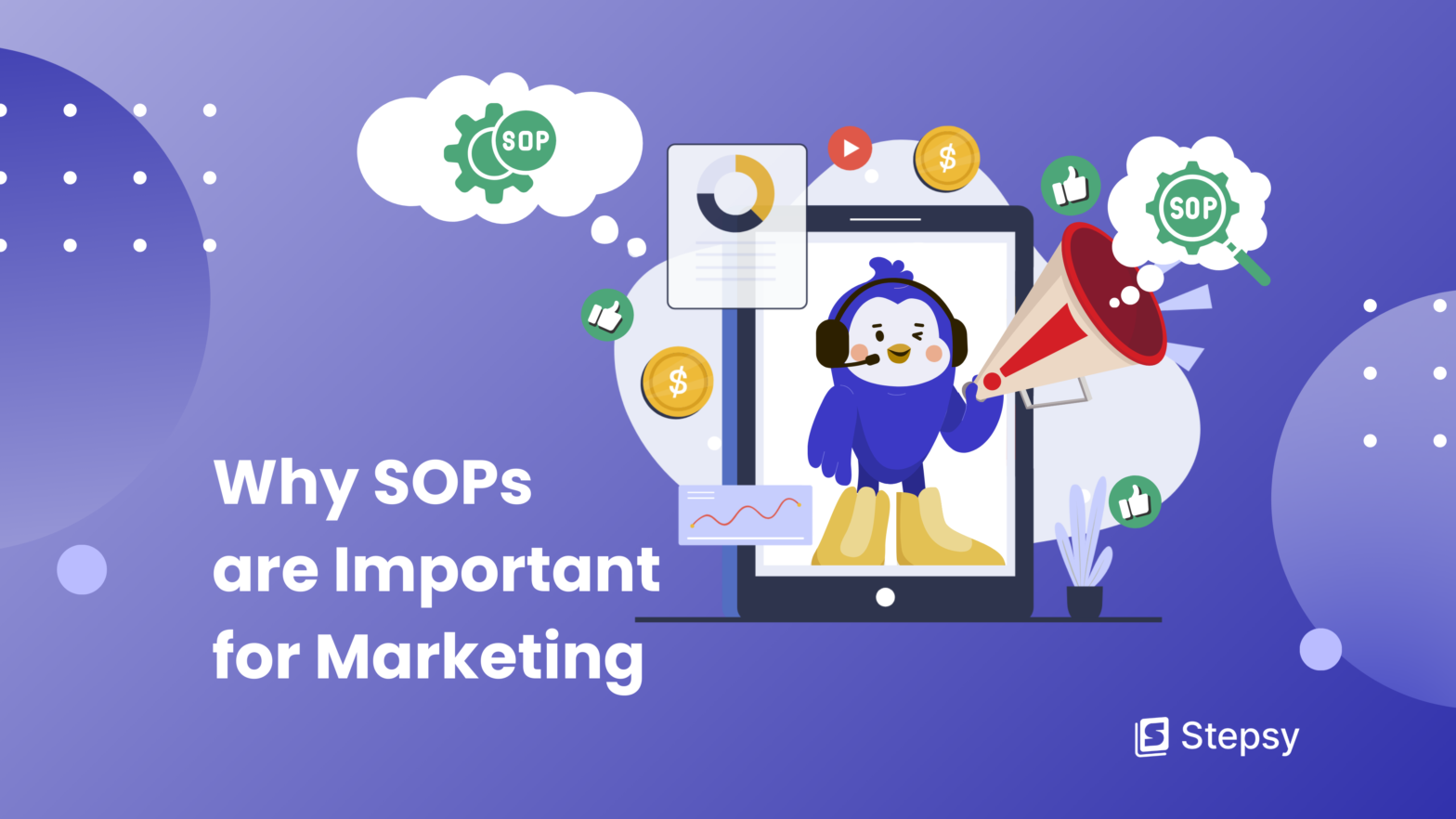
 Iryna Smuk • 01 Jul 2024
Iryna Smuk • 01 Jul 2024
Imagine a symphony orchestra preparing for a grand performance. Each musician knows their part, the conductor guides their movements. The result is harmonious music that captivates the audience. In digital marketing, SOPs play a similar role — they orchestrate processes, streamline operations, and ensure seamless performance.
Standard operating procedures (SOPs) are comprehensive, step-by-step instructions, designed to help employees carry out routine operations. But what is SOP in marketing? A Marketing Standard Operating Procedure is a repeatable instruction that describes how to perform a marketing task by following a series of steps in order to achieve a consistent approach and produce positive outcomes.
So, let’s take a look at the specific need for SOP in marketing, and its benefits as well as explore how to create effective standard operating procedures.
Roles of Standard Operating Procedures in Marketing
Although the value of SOPs is well-recognized in various business operations, their importance in the marketing sector cannot be overstated. Marketing standard operating procedures provide a framework that supports various essential functions.
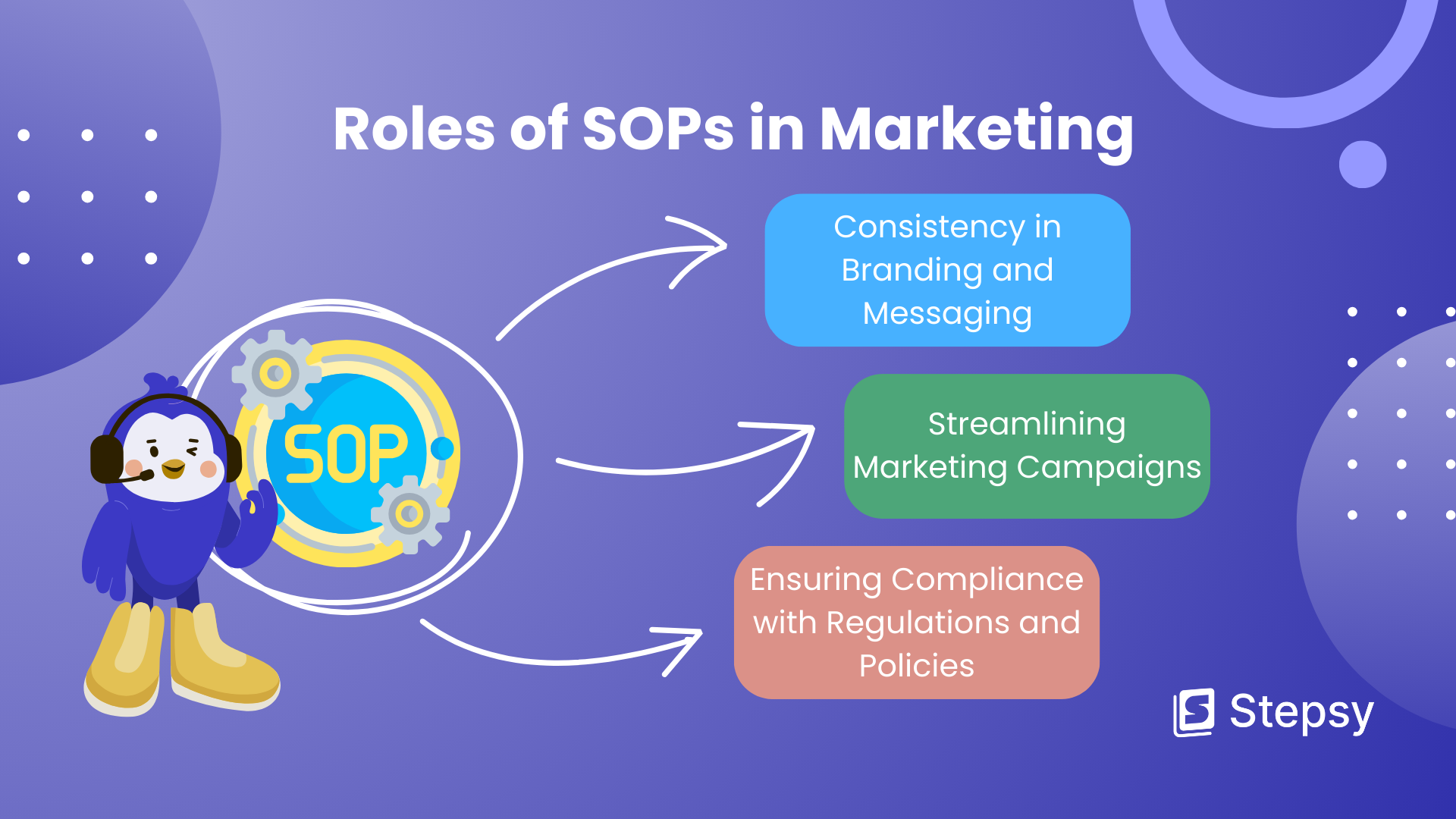
Consistency in Branding and Messaging
One of the most critical roles of SOPs in marketing is maintaining consistency in branding and messaging. They make certain that every piece of content, from social media posts to email campaigns, aligns with the brand’s voice, style, and identity. Thus, this uniformity helps build a recognizable brand while fostering customer loyalty and trust. With SOPs in place, marketing departments can produce cohesive and compelling communications that resonate with their audience.
Streamlining Marketing Campaigns
The Right SOP for digital marketing is a magic formula for marketing success in creating and executing campaigns. They offer clear instructions and timelines for each phase of a campaign. Right guides minimize confusion and errors, allowing marketing team members to work more efficiently and focus on creativity and strategy. Additionally, they facilitate better coordination among employees, ensuring that everyone is on the same page and working towards the same objectives.
Ensuring Compliance with Regulations and Policies
Any marketing department needs to ensure compliance with laws and internal policies. SOPs help safeguard against legal issues as they outline the necessary steps to comply with regulations, such as data protection laws and advertising standards. Standard operating procedures provide a reference for marketers to follow, reducing the risk of costly mistakes and guaranteeing that all marketing activities are conducted ethically and legally.
Types of SOPs in the Marketing Department
There are different types of standard operating procedures for marketing agencies to utilize. Here are outlined some SOP examples for specific business processes in the marketing department:
| Process | Type of Marketing SOP |
| Social Media Management |
|
| Campaign Planning and Execution |
|
| Content Creation and Management |
|
| Market Research and Analysis |
|
Benefits of SOPs in Marketing
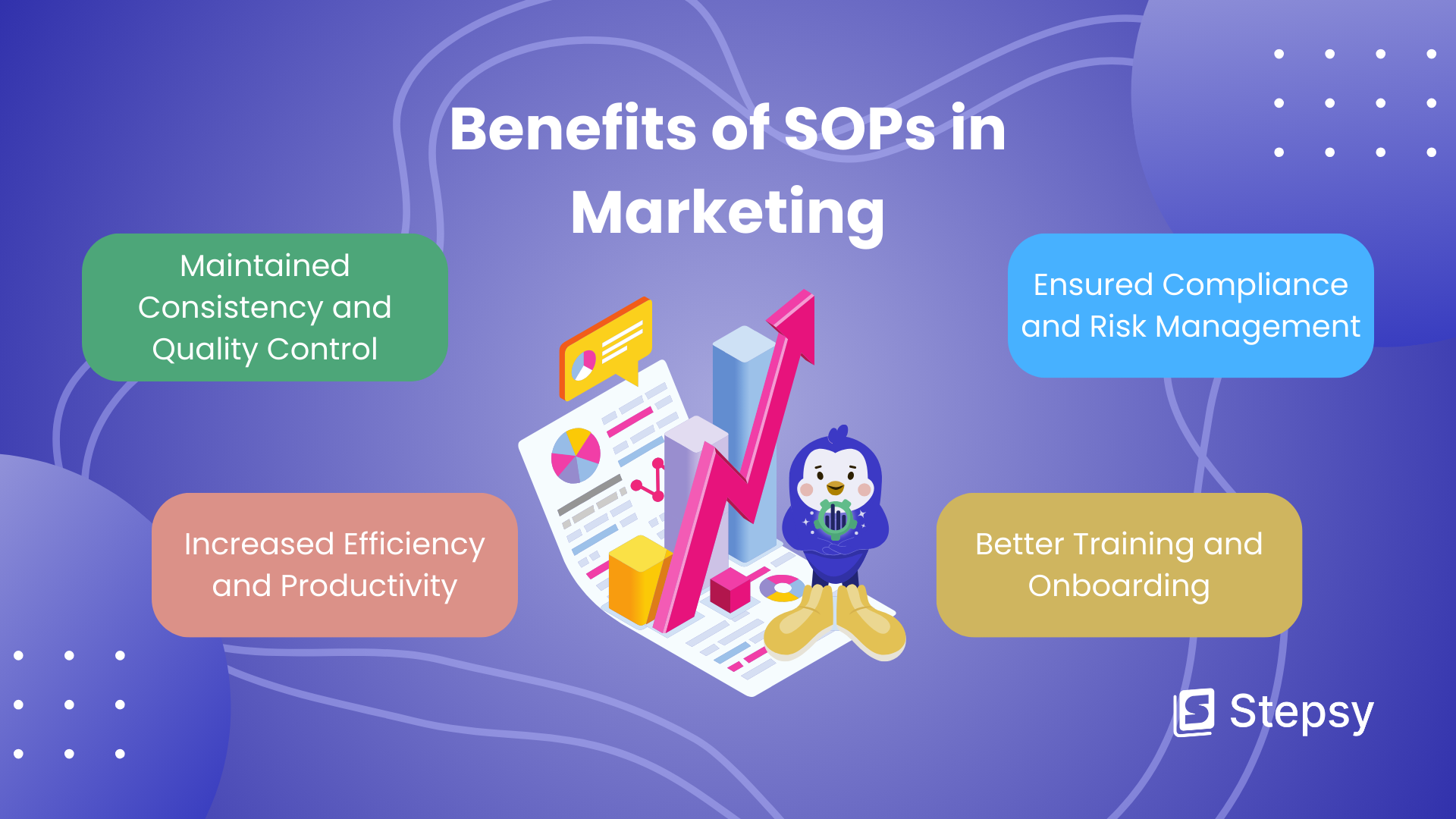
Consistency and Quality Control
Maintaining consistency is significant for effective marketing. That’s where SOPs present their advantage. When every team member follows these procedures, marketing agencies ensure their work aligns with the established brand identity.
Standard operating procedures can also establish clear workflows for creating and reviewing marketing materials. Checklists within SOPs can make sure that all crucial quality checks are completed before materials are published or distributed. Furthermore, such documentation helps reduce errors and omissions that can detract from the high standard of quality of marketing content.
Efficiency and Productivity
Standard Operating Procedures are instrumental in boosting efficiency and productivity within marketing teams. As they define procedures, members of the team know exactly what steps to follow. It leaves no room for confusion and missteps. SOPs can also eliminate redundant tasks and confirm that no effort is wasted on unnecessary or duplicate work.
One study revealed that 60% of employees report that it is difficult, very difficult, or nearly impossible to obtain information from their colleagues needed to do their jobs.
That’s why, SOP is a great solution that enables workers to get the information they require, and not wait for it from marketing experts. What previously used to take tons of time can now be accomplished faster with clear instructions — allowing you and your team members to focus on what truly matters: strategic activities and creative tasks that drive results.
Training and Onboarding
Consider a scenario in which there is no defined onboarding procedure for newly hired staff members. Some might receive a comprehensive welcome, while others get a rushed introduction. Such inconsistency can hinder new employee integration and even impact staff retention.
According to The Wynhurst Group’s research, new hires who participated in a structured onboarding program were 58% more likely to be with the organization after three years.
That’s where SOPs step in and create a foundation for a structured and consistent approach to training and onboarding new team members within the marketing department. They make sure that every newcomer receives the same information and guidance, reducing the risk of overlooking important details.
| Implementation of SOPs | Result |
| A marketing team implements an SOP for social media content creation | It saves time, as its team members follow predefined templates and approval workflows. This reduces the back-and-forth typically involved in content review and ensures timely publication. |
| A marketing team implements an SOP for email marketing campaigns | Team members quickly set up, test, and deploy emails due to a standardized process. This not only saves time but also confirms that all necessary steps, such as list segmentation and A/B testing, are consistently performed. |
Compliance and Risk Management
Other benefits of SOPs in marketing are securing compliance with legal and industry regulations as well as managing risks. They help marketing staff adhere to regulations. This in turn not only protects the company from legal repercussions but also builds trust with customers and demonstrates a commitment to ethical practices.
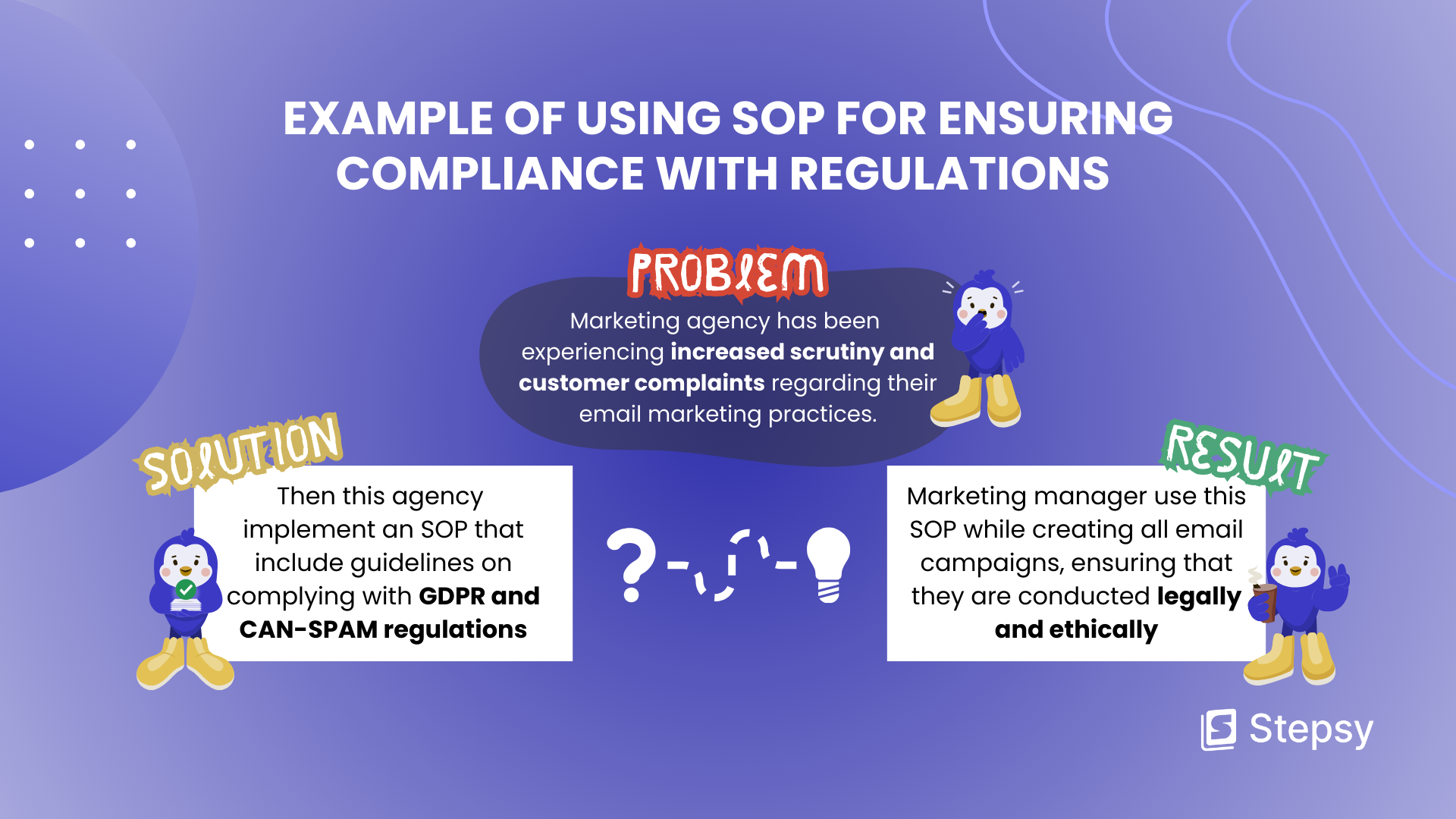
Moreover, clear and documented procedures within SOPs help your team mitigate errors in areas like targeting, messaging, and content marketing. So, if you want to reduce the risk of offensive or misleading marketing campaigns that can damage your brand reputation, one right way is to implement SOPs.
Developing Effective Marketing SOPs
Identifying Key Processes
The best way to create effective SOPs is to start by identifying the key processes that need to be documented. You can pinpoint these critical processes in a couple of steps. Use this guide, it will help you to complete this task:
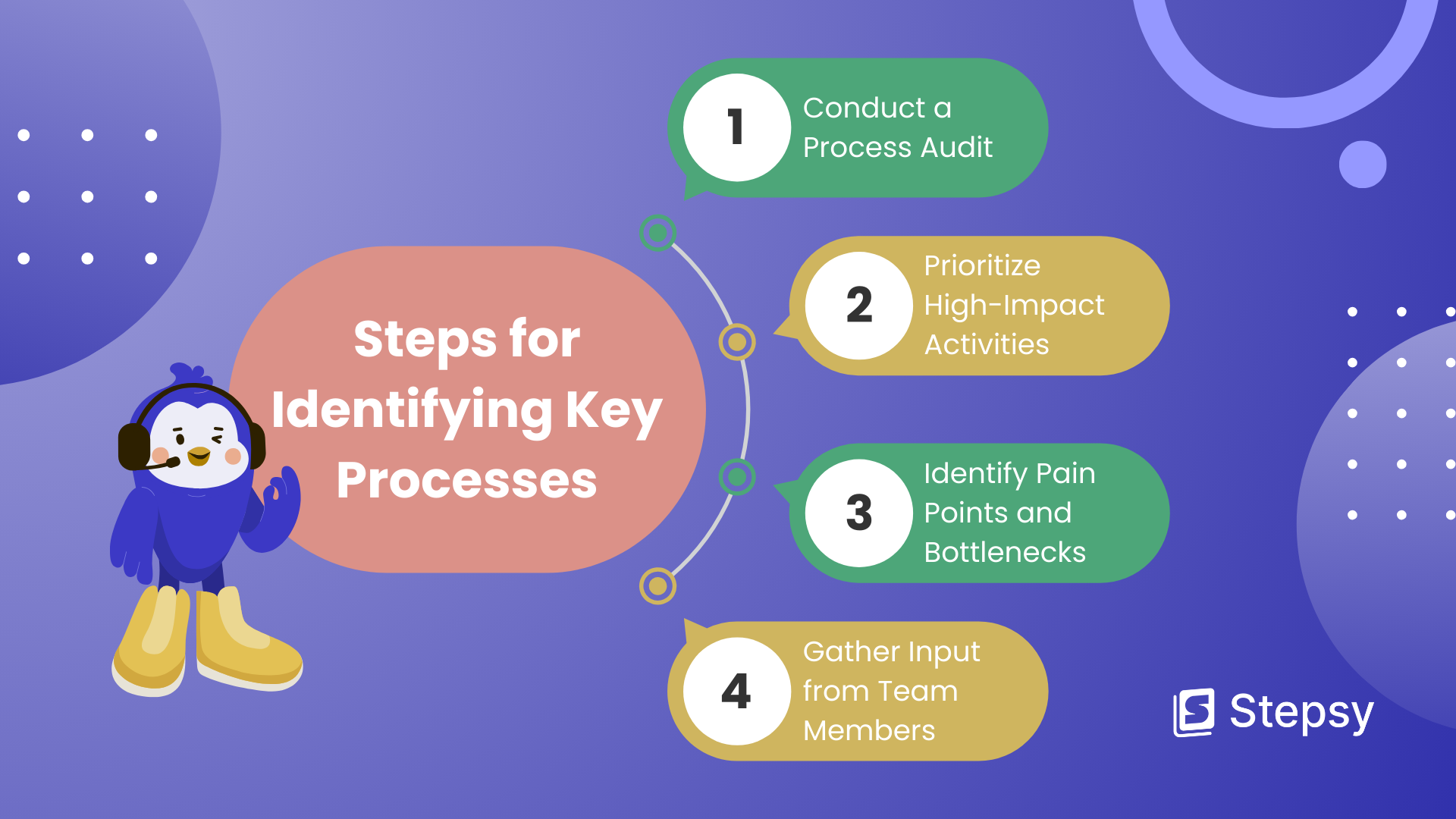
Step 1: Conduct a Process Audit
Perform a thorough audit of all marketing activities. Map out every task and operation within your marketing department, from content creation and social media management to campaign execution and analytics. When you understand the full scope of your marketing efforts, you can identify which processes are most crucial and repetitive.
Step 2: Prioritize High-Impact Activities
Then you should prioritize the activities that have the most significant impact on your marketing goals. These high-impact processes are often the most beneficial to document, as they contribute significantly to your overall marketing success.
Step 3: Identify Pain Points and Bottlenecks
Furthermore, it is important to identify areas where inefficiencies, errors, or bottlenecks frequently occur. They often highlight the need for clear, standardized procedures.
Step 4: Gather Input from Staff Members
Your employees, like no one else, have valuable insights into which procedures need SOPs. They handle these tasks daily and their feedback can help ensure that the instructions you develop are practical and efficient.
Documentation and Format
Now, that you pinpointed key processes, you need to document them effectively. Begin with outlining the objectives and scope of each SOP guide. The aim should be as clear as glass. What do you want to achieve with SOP? Which tasks or processes does it cover? Answer these questions to make guides focused and relevant.
It is desirable to divide the procedure into manageable steps. Then make sure to include all necessary details. SOPs have to define who is responsible for each step in the process.
Although, there’s no one-size-fits-all approach to SOP formatting. It depends on the complexity of the process being documented. However, we prepared some tips and common options for you to consider:
- Visual Aid: Incorporate visual aids such as flowcharts, diagrams, and screenshots to complement the written instructions. They can help clarify complex processes and make the SOP more user-friendly.
- Headings and subheadings: Divide the document with clear and concise headings.
- Bullet points and numbered lists: Include them to present steps, procedures, or lists of requirements.
- Consistent formatting: Use the same font size, style, and spacing throughout the document.
- Step-by-Step Checklists: Checklists are simple and effective for capturing straightforward procedures, as they allow users to tick off tasks as they complete them.
- Marketing SOP templates: They present a consistent format for documentation, making it easier to create SOPs and follow them.
- Appropriate software: Make sure you’re utilizing the tools that allow you to simplify the SOP’s creation process.

Implementation and Training
Developing effective SOPs is the first step, but implementing them is equally important. If workers don’t know SOPs in your company exist or how to use them correctly, even the most well-written documents won’t have the desired effect. Thus, offering comprehensive training ensures that all members of your marketing team can use SOPs efficiently.
Here is a scenario that shows different outcomes of the task being performed by a trained-to-use SOP employee vs. an untrained one:
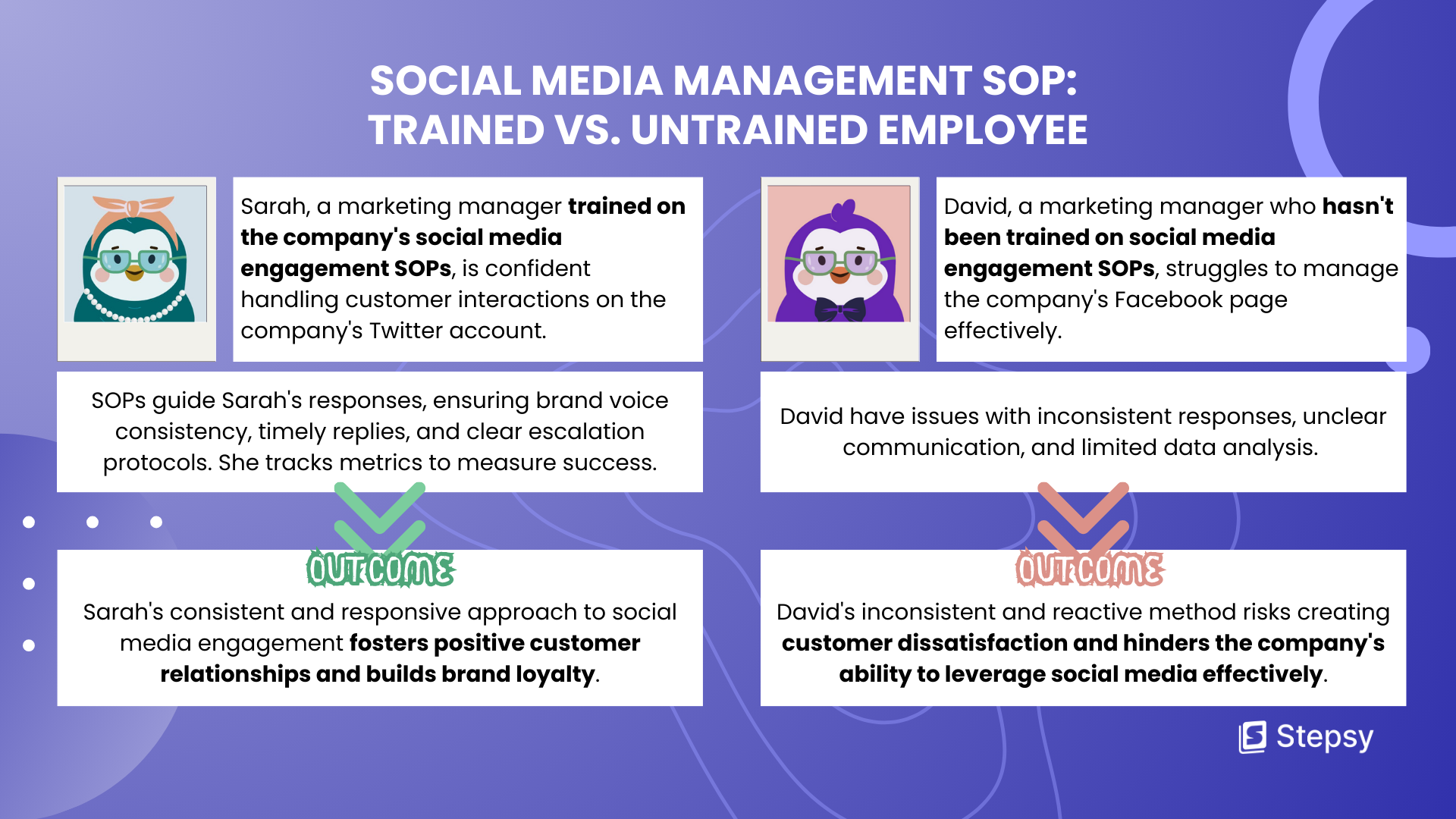
So, we assembled bits of advice to make sure that your teams get the most out of SOPs:
- Conduct Initial Training Sessions: Introduce SOPs to your team, and provide a detailed walkthrough of each SOP for relevant workers. Then, you can engage them in interactive training sessions or webinars, where they can ask questions and participate in discussions. Also, marketing companies can benefit from SOPs if they allow employees to practice using them in a controlled environment.
- Create Accessible Resources: Guarantee that all SOPs are easily accessible in digital format. You can use cloud-based storage solutions like Google Drive, Dropbox, or your company’s intranet to store and share them. Plus, consider providing printed copies of SOPs for those who prefer physical documents.
- Implement Ongoing Training and Support: Schedule regular training sessions to reinforce the use of SOPs and introduce any updates or new procedures. Establish a feedback system where team members can share their experiences and suggest improvements to instructions. Additionally, monitor the performance of the team in following the SOPs.
Review and Update
SOPs aren’t static documents. They need to be reviewed and updated regularly to remain relevant and effective. Businesses should evaluate current SOPs to identify any gaps or areas for improvement.
For this to work, they need to make necessary updates based on feedback from the marketing team and changes in the industry. It’s helpful to establish a schedule for reviewing SOPs, such as quarterly or annually, and involve key stakeholders in the review process.
Conclusion
Hence, Standard Operating Procedures (SOPs) represent a fundamental aspect of achieving success in marketing. They offer a structured approach to managing marketing activities, ensuring consistency, quality, efficiency, and compliance. Marketing teams can streamline their workflows, enhance productivity, maintain a consistent brand voice, effectively train new hires, and ensure compliance with regulations.
To create powerful SOPs for digital marketing agencies, start with identifying key processes and documenting them. Then you should implement SOPs and train your employees. And don’t forget to regularly review and update them.
If you haven’t already, now is the time to start developing or refining your marketing SOPs to unlock their full potential.
